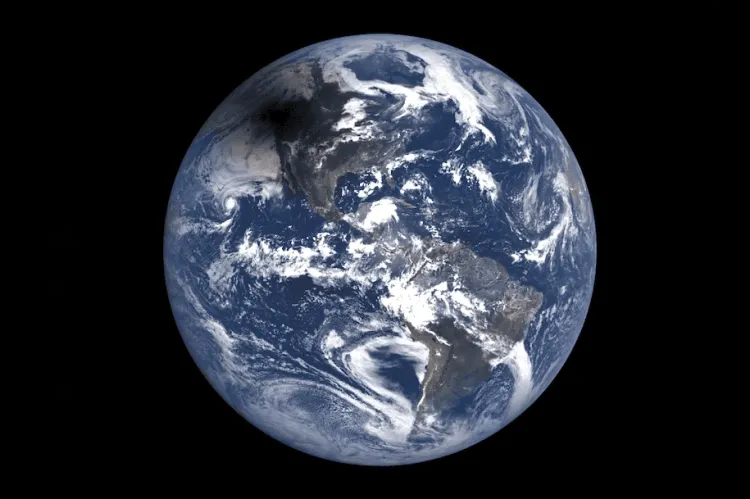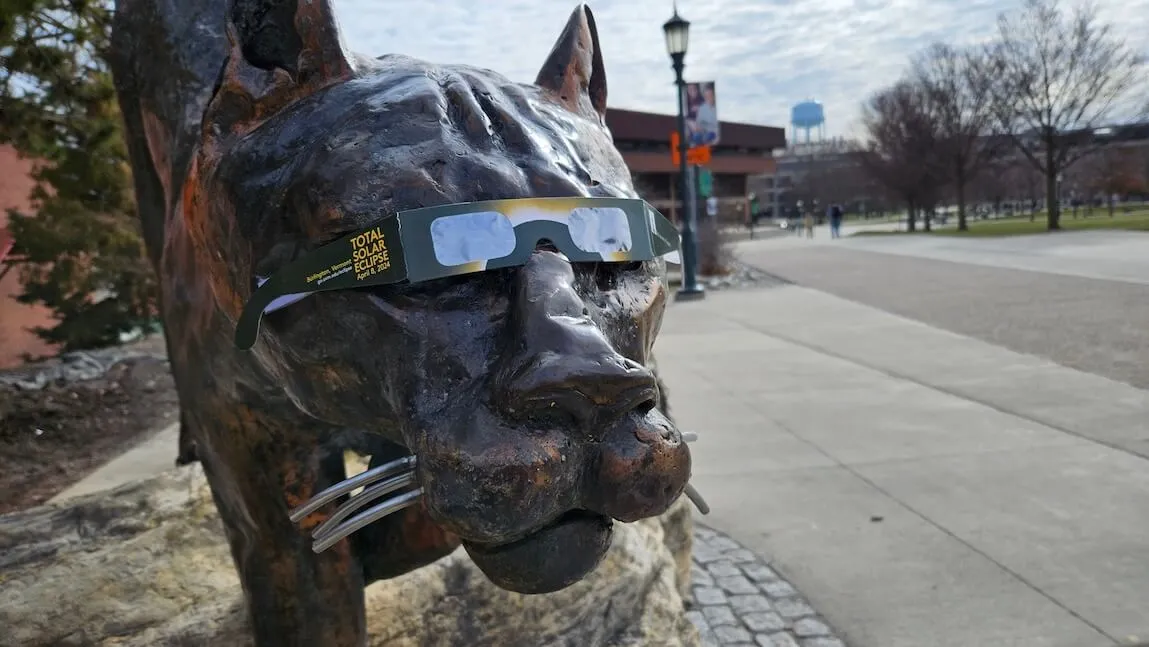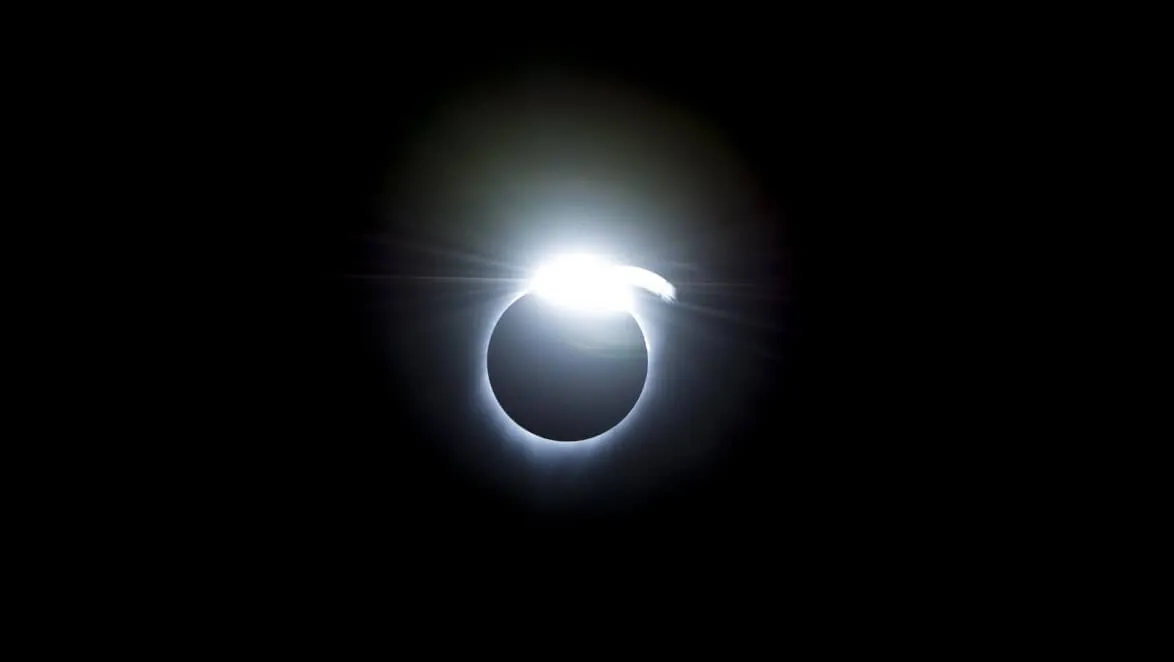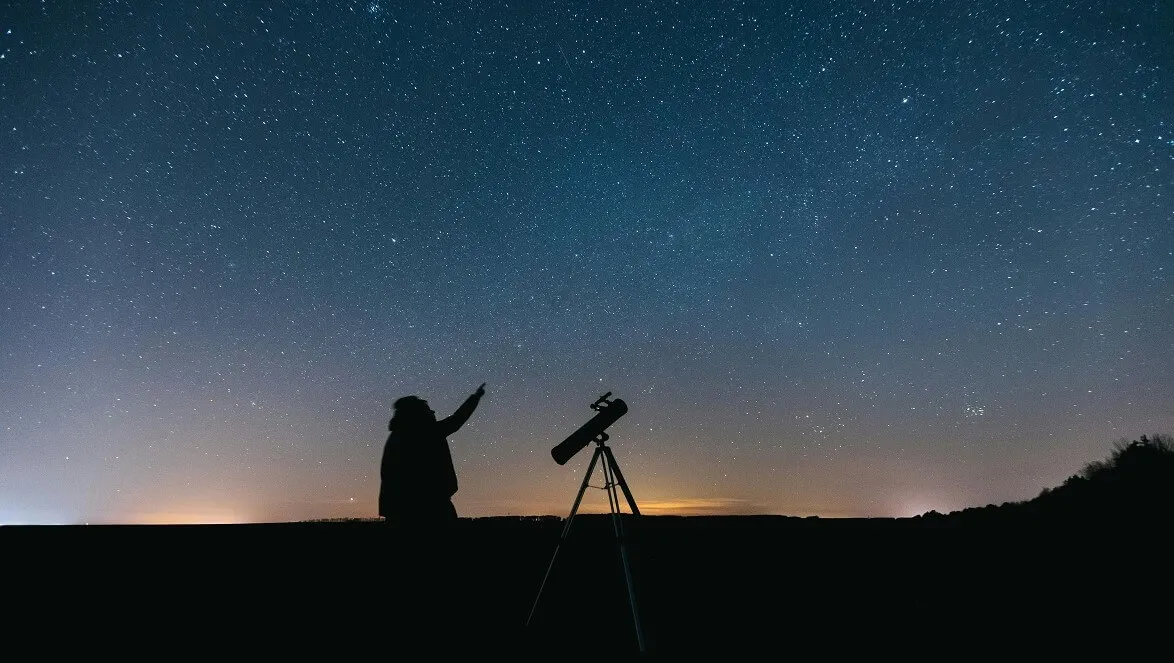Monday, April 8 will find thousands of people across North America focused skyward to view the total solar eclipse that will affect the entire lower-48 U.S. states and throw a narrow band of brief, complete mid-day darkness along a path from Texas to New England. In Vermont, if skies are clear, the total eclipse will be visible in mid-afternoon north of a line extending roughly from Crown Point through Barre to Lunenburg. (See this Vermont Public map of the eclipse path.) Within this area the Moon will pass directly in front of the Sun, completely blocking its light, and revealing its glowing gaseous outer “corona.”
In Burlington, the sky will begin to partially darken at 2:14 pm, as the Moon slowly covers the Sun; totality will last from 3:26 to 3:29 pm, with the Moon finally exiting the Sun’s path at 4:37 pm. The Moon casts a fairly small disc-shaped shadow, so the duration of totality can vary significantly depending on how close a location on the ground is to the center line of the disc. Precise eclipse times and duration for other locations can be found using the “timeanddate” site’s interactive map.
Total eclipses in populated areas are true rarities: the next one in the continental U.S. will occur 20 years from now. The last total solar eclipse visible in Vermont happened in 1932. This uncommon event is expected to draw thousands of visitors from outside Vermont – perhaps as many as 160,000 by some estimates – and many central and southern Vermonters will travel northward that day into the total eclipse zone. Potentially crowded conditions, and the nature of eclipse viewing itself, call for caution and planning to make the experience of this rare event a positive one.
Safe Viewing and Recording
The Sun is the source of life and energy on Earth, but directly viewing our nearest star is inherently dangerous. Never directly stare at the Sun with the naked eye – this can cause severe retinal burning and blindness. The only way to safely have a direct view of the path of the Moon across the Sun’s disc is with special solar eclipse glasses. UVM students, faculty, and staff can access solar viewing glasses (see the first part of the Q&A on UVM’s eclipse information webpage), and many public libraries and town clerks throughout Vermont are also distributing them. Regular or polarized sunglasses do not block the Sun’s harmful rays and cannot be substituted for solar viewing glasses. The only time direct viewing is safe is during the actual brief period of totality, when the Moon completely blocks the Sun. As soon as totality ends, your solar viewing glasses should be used again to prevent eye damage.
Looking at the Sun with the unaided eye is dangerous, but viewing it through binoculars or a telescope or a camera viewfinder can be even more harmful to your retinas. Never use these devices to look directly at the Sun. Binoculars or telescopes can be used to project a safe image of the eclipse as it waxes and wanes. The American Astronomical Society provides instructions for safe pinhole and optical projection. Prolonged direct exposure to the Sun by digital cameras, including smartphone cameras, can cause permanent damage to their optical sensors. B&H Photo has an informative article that offers extensive tips on how to safely photograph a solar eclipse.

NASA's Earth Polychromatic Imaging Camera (EPIC), from its vantage point a million miles away from the Earth, took this photo of the Moon's shadow over the Pacific Northwest states during the 2017 total solar eclipse. April 8th's eclipse will send a similar shadow over a path through Mexico northeast to eastern Canada, including along the way Vermont and 14 other states.
(Photo by NASA EPIC Team)
The Burlington and Campus Experience
On the UVM campus, the key source for eclipse-related information is the Vermont Space Grant Consortium site. This site includes listings for a range of fun and informative events taking place on campus on April 8.
While most regular instructional activity will not occur, the campus will be open and operating regularly to support an Alternative Instruction Day for students. Faculty and staff who regularly meet with and support students are encouraged to be present and take part in the array of on-campus activities planned for the day. (Student-facing offices may be closed during the period of the eclipse itself, beginning at 2:14 pm.)
Due to anticipated increased numbers of visitors to the area, UVM managers should give careful consideration to staffing. It will be appropriate for some employees to work from home on April 8, but the university is not closed and to the extent possible, student-facing offices should be staffed in-person. Managers should coordinate with their teams to support flexibility while maintaining appropriate on-campus staffing, and supervisors and employees with questions should contact their next-level supervisor for additional guidance.
The UVM CATAlert system will, as always, keep users informed of any emergency information. If you are a student, faculty, or staff member you are signed up for this system using contact information the University has for you. Anyone not already signed up, or who wishes to receive CATAlerts using an additional phone number or email address, can visit the CATAlert website.
The Vermont Emergency Management division of the state’s Department of Public Safety maintains the VT-ALERT system to notify state and local responders and the public of emergency situations. Sign up for VT-ALERT. The state has also established a dedicated text notification system for the event to convey weather, traffic, and other information; text VTECLIPSE to 888777 to register.
Vermont cell phone service providers have said they expect their networks to be able to handle increased call volumes on April 8. Nevertheless, some connectivity may be slowed. All 911 cell calls will, as always, receive priority routing from providers.
The UVM Guest wireless network will be turned off between 7:00 am and 7:00 pm on April 8 as a preventative measure in anticipation of a potentially untenable increase in user volume. With the projected number of people anticipated to be on campus, the ability for the existing wireless access points to handle the additional population would likely be compromised and all users - guests as well as UVM community members - would experience difficulties. The normal UVM authenticated wireless will still be available for people with an active UVM NetID.
Additionally, technical support staff will be available for remote support on that date. The ETS Tech Team and helpline staff will be available by phone, email, or footprints, but the walk-in location will be closed. Contact the tech team through the UVM Knowledge Base.
Both Vermont and Burlington authorities also have online guides with extensive eclipse information. Information in languages other than English is available on the Vermont state site, and Burlington offers an email sign-up to receive regular updates.
On and Off the Roads
Traffic volume is likely to become an issue on Eclipse Day. It is important to anticipate potentially lengthy delays in travel to, from, and around campus that day and plan accordingly – including having food, water, and other necessities in your vehicle. It is expected that traffic may be particularly congested in the hours immediately following the eclipse.
Due to expected traffic delays, the Given Mailroom and Waterman Mailroom will not be sending shipments to Fed Ex, UPS, and USPS on April 8. In addition, there will not be any pickups from vendors that day. The drivers for Print & Mail will not be delivering to residence halls or campus departments. This may cause a delay in package deliveries across campus.
Major Vermont roads can be monitored in real time at New England 511. The City of Burlington has extensive road closures on April 8 detailed on their online map.
Away from campus, many road conditions in Vermont may be challenging to visitors. Unpaved roads can become dangerous, difficult, or impossible to drive on during mud season. Don’t drive onto a muddy or water-covered road, especially if there are signs advising you to stay off or turn around. If the road is closed, there’s a reason – don’t chance it.
Higher-elevation areas in Vermont can become cold, rainy, foggy, icy, and snowy, even in the spring. The conditions at the trailhead are likely different from those at higher elevations. Trails in Vermont are often closed at this time of year due to muddy conditions, as well as to prevent disturbing sensitive wildlife, including nesting birds. Please respect these restrictions – they are there for your safety and to prevent damage to sensitive ecosystems and species. The Green Mountain Club and the Vermont State Parks have both provided information about how best to avoid damaging Vermont’s sensitive trails and environment while seeking a spot to enjoy the eclipse.
Seldom does a natural event occur that causes such dramatic change, but leaves behind no permanent traces. Instead, the Total Eclipse of 2024 will live on in the memory of Vermonters, and all those who temporarily become Vermonters on April 8. We have good reason to savor the experience: the Green Mountain State will not experience another total eclipse until May 1, 2079. And astronomers tell us that, since the Moon is slowly moving away from the Earth by about 1.5 inches every year, there will come a time about 600 million years from now when the Moon’s disc will no longer completely cover the Sun. Which means that total eclipses are not only rare, there is also, ultimately, a limited supply of them. Let’s safely enjoy this one while we can.


